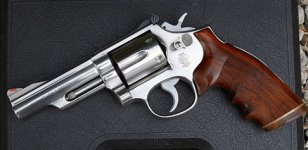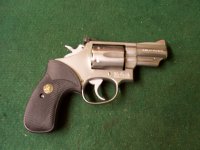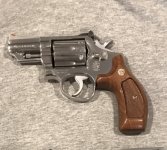The Model 66 started out in 1955 as the blued steel Model 19.
Famed Border Patrolman Bill Jordan convinced S&W that the American lawman needed a medium "K" frame revolver chambered in .357 Magnum.
His idea was a premium revolver with adjustable sights and a heavy shrouded barrel and target grips that would be fired with .38 Special ammo for practice, but carried on duty with full charge .357 Magnum ammo.
The new Model 19 Combat Magnum was an instant hit with lawmen and set up S&W to dominate the law enforcement handgun market up until the Glock appeared.
In the late 60's S&W began making stainless steel revolvers with the Model 60 Chief's Special snub nose .38.
In 1971 they began making the Model 19 in stainless steel and called it the Model 66 Combat Magnum.
This became THE law enforcement revolver until the beefed up "L" framed Model 686 Distinguished Combat Magnum was introduced in 1981.
The Model 66 was offered in 2 1/2", 3", 4", and 6" inch versions.
The 3" is a rare limited issue, and is considered by many to be the ultimate medium frame carry revolver.
Due to the use of the old medium "K" frame the Model 19 and Model 66 were not intended for extended use with full power .357 ammo, but they are not as fragile as thought.
The major problem with the .357 "K" frame models is that extended shooting of the hot 125 grain jacketed hollow point loads could cause the forcing cone to erode and even crack.
This was basically metal fatigue caused by the fast moving 125 grain bullet striking the forcing cone and the erosive effect of the hot burning powder.
This appeared because the police stopped practicing with light .38 Special loads and mandated practice with full power duty loads.
The much heavier use of the police favorite 125 grain jacketed bullet loads began to over stress the thinner forcing cones, which in the "K" frame has a flat on the bottom of the barrel to allow clearance for the cylinder yoke to close.
A major contributing factor was that many of the guns with cracked forcing cones had badly fouled forcing cones and that was thought to be a major contributor in the cracking.
To help prevent forcing cone problems, buy a Brownell's Lewis Lead Remover Kit. This is used to remove leading from the bore, but the kit includes a special cone-shaped tip that with a brass screen over it, cuts forcing cone fouling off, including the carbon and copper fouling of jacketed bullets.
Even if you don't shoot lead bullets you should still use the Lewis Kit forcing cone cleaner.
Possibly because of the stainless steel construction the Model 66 seemed to have much less a problem with forcing cone cracking or erosion then the carbon steel Model 19 did.
The large majority of "K" frames that had cracked forcing cones were the Model 19's.
Considering that no new barrels are available, it's still thought best do practice with .38 Special or .38 Special +P ammo, and reserve the .357 Magnum loads for "business" carry.
Another way to limit potential problems is to use mostly the 158 grain Magnum loads. These have a much less problem with forcing cone issues.
Another excellent way to have near-Magnum performance is with the Buffalo Bore 158 grain, lead semi-wadcutter, hollow point .38 Special +P load.
This is a duplicate of the original police issue +P .38 Special load.
Back in the 60's the police were facing more violent criminals, often high on drugs, and they began having many failures to stop with the old standard 158 grain round nose lead bullet load that had been police standard since the early 1900's.
This old load got a reputation as a "widow maker" when police were killed after the ammo failed to stop the attacker.
After a number of police unions and widows sued departments the +P 158 grain, lead semi-wadcutter, hollow point loads were developed.
This ended the failures to stop, and the +P load became known to street cops as the ".38 SPLAT", for the sound it supposedly made when it hit.
These loads were known as the Federal, St. Louis, Chicago, New Orleans, LAPD, etc loads, depending on where you lived.
Over the years the ammo makers have down loaded the original +P to a level not much higher then the original standard .38 Special.
Buffalo Bore has a +P load much like the original lead wad-cutter load.
This has a special softer lead bullet with a gas check crimped on the back of the bullet to allow driving it at near-Magnum velocity, but not lead up the barrel.
If you don't want the ear-splitting CRACK of the full charge Magnum ammo in enclosed spaces like a home or car, these loads are a great substitute that still offers plenty of fight stopping power with much less muzzle blast and noise.
This type load had an excellent reputation with the police, and it's still an excellent choice for CCW carry in the Buffalo Bore loading.
https://www.buffalobore.com/index.php?l=product_detail&p=108
Finally, my own Model 66 revolvers.
I once also owned a 4 inch version.
The 3 inch is one of those sold through Ashland Shooting Supplies back in the 80's. These are rare and bring premium prices:










